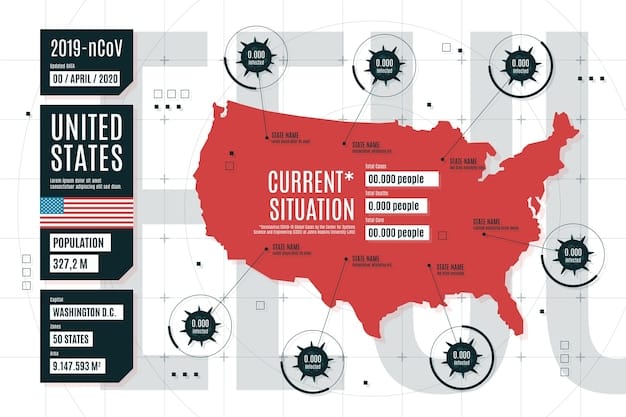Tax Credits Boost Independent Filmmaker Budgets in 2025

Independent filmmakers are increasingly leveraging state and federal tax credits to significantly enhance their production budgets in 2025, transforming project viability and fostering regional film economies across the United States.
The independent film landscape is perennially challenged by budget constraints, a reality that often stifles creative vision and limits production scale. However, a significant game-changer is emerging for 2025: the strategic use of tax credits. Understanding Behind the Scenes: How Independent Filmmakers Are Using Tax Credits to Boost Production Budgets in 2025 reveals a nuanced interplay of financial incentives and strategic planning, empowering a new wave of cinematic projects.
The Evolving Landscape of Film Tax Incentives in the US
The concept of film tax incentives is not new, but its application and impact on independent filmmaking are undergoing a significant evolution. For 2025, states are refining their programs, making them more accessible and attractive to smaller productions. These incentives, which can come in the form of tax credits, rebates, or grants, are designed to stimulate local economies by encouraging film and television production within their borders.
Understanding the nuances of these programs is crucial. Each state has unique requirements, ranging from minimum spending thresholds to specific hiring quotas for local crew and talent. For independent filmmakers, navigating these complexities can be daunting, yet the potential financial returns make the effort worthwhile. It’s a strategic dance between creative ambition and fiscal prudence.
State-Specific Programs and Their Benefits
Various states offer distinct advantages for filmmakers utilizing their tax credit programs. California, for instance, known for its robust industry, provides competitive credits aimed at keeping productions within the state. States like Georgia, New York, and Louisiana have also established themselves as major production hubs due to their generous and stable incentive programs.
- California: Focuses on non-feature films, independent features, and relocating TV series, often providing credits up to 25% of qualified expenditures.
- Georgia: Offers a flat 20% tax credit, with an additional 10% if the project includes an embedded state promotional logo, making it very attractive for a wide range of productions.
- New York: Provides a 30% credit for qualified costs, with higher incentives for productions in specific upstate regions, fostering economic development outside NYC.
These varying structures mean that a production eligible for certain credits in one state might not be in another, necessitating careful pre-production planning. Filmmakers must align their script, budget, and logistical needs with the available incentives to maximize their financial leverage.
Navigating the film tax incentive landscape requires more than just understanding the percentages. It demands a deep dive into the eligibility criteria, application processes, and compliance requirements. For independent filmmakers, this often means seeking expert advice from tax credit brokers or specialized production accountants who can guide them through the intricate legal and financial frameworks.
Strategic Financial Planning: Maximizing Tax Credit Utilization
For independent filmmakers, tax credits are not merely a bonus; they are an integral component of the financial model. Strategic financial planning involves identifying potential credits early in the development phase and structuring the budget to maximize their utilization. This proactive approach can unlock significant funds, transforming a modest budget into one capable of supporting higher production values, better talent, and more extensive marketing efforts.
One of the primary ways filmmakers maximize these credits is by understanding “qualified expenditures.” These typically include salaries for local cast and crew, equipment rentals from in-state vendors, and other production-related costs incurred within the jurisdiction offering the credit. By consciously directing spending towards these categories, filmmakers can significantly increase their eligible credit amount.

The Role of Specialized Consultants and Brokers
The complexity of state and federal tax credit programs has given rise to a specialized ecosystem of consultants and brokers. These professionals possess an in-depth understanding of the ever-changing regulations and can navigate the application and monetization processes. For an independent production team, engaging such experts can be the difference between securing substantial funding and missing out on crucial support.
- Expert Guidance: Consultants advise on which states offer the best fit for a project’s specific budget and creative needs.
- Application Management: They assist with the meticulous paperwork and compliance requirements, ensuring all deadlines are met.
- Credit Monetization: Brokers help filmmakers sell their transferable tax credits to third parties, providing immediate cash flow back into the production.
This monetization aspect is particularly vital for independent films. Many tax credits are not direct cash grants but rather reductions in tax liability. For a film production, which may not have significant tax liability in its early stages or for a single project, selling these credits to a company that does can provide an immediate cash injection, bridging critical funding gaps.
Furthermore, early engagement with these specialists allows filmmakers to design their production plan with tax credits in mind from the outset. This could include scouting locations in states with strong incentives or making pre-emptive hiring decisions that align with local labor requirements to ensure maximum eligibility for credits.
Case Studies: Independent Success Stories in 2024-2025
Examining recent examples illuminates the practical impact of tax credits on independent film production. In 2024, several indie projects, initially struggling to secure full financing, found renewed vigor by strategically utilizing state incentives. These stories are critical for understanding how the system truly works for the smaller, more agile production companies.
One notable example is “Echoes from the Valley,” an independent drama filmed in New Mexico. The production leveraged New Mexico’s robust film tax credit program, which offers up to 35% of qualified expenditures. By hiring a predominantly local crew and utilizing local vendors, the filmmakers not only reduced their production costs but also fostered a strong sense of community involvement. This strategy allowed them to allocate more funds to post-production and marketing, ultimately enhancing the film’s marketability and reach.
Diverse Projects, Diverse Applications
The application of tax credits is not limited to narrative features. Documentaries, short films, and even innovative web series are finding ways to benefit. A documentary series focused on environmental issues, “Green Horizons,” secured funding through a combination of grants and a specialized state tax incentive aimed at educational content produced in Massachusetts. This allowed the team to invest in high-quality aerial cinematography and extended field research, elements that would have been financially out of reach otherwise.
- Horror Film “The Silent Grove”: Utilized Louisiana’s 25-40% tax credit to build elaborate practical sets, investing in creature effects that significantly elevated the production value.
- Romantic Comedy “City Lights”: Filmed in a smaller, emerging film hub in North Carolina, benefiting from a nascent but growing incentive program that attracted talent by offering competitive local wages, partially offset by credits.
- Animated Short “Pixel Dreams”: Though smaller in scale, used a state digital media incentive in Oregon, demonstrating that even niche independent projects can find relevant financial support.
These diverse projects highlight a critical takeaway: tax credit programs are not monolithic. Their variations allow for a wide array of productions to find suitable homes and financial boosts. The success stories often share a common thread: meticulous planning, an understanding of local regulations, and a willingness to adapt production logistics to maximize incentive eligibility.
For independent filmmakers, these case studies serve as powerful testimonials. They illustrate that with strategic foresight and a readiness to engage with the financial mechanisms available, ambitious projects can move from concept to screen without compromising artistic integrity due to financial constraints. The competitive landscape for indie films still exists, but tax credits are undeniably leveling the playing field.
Navigating State-Specific Requirements and Compliance
The allure of film tax credits is undeniable, but the path to securing and utilizing them is paved with stringent requirements and a complex compliance process. Each state operates under its own set of rules, and understanding these specifics is paramount for independent filmmakers looking to avoid pitfalls and ensure successful project funding. This often begins with the application phase, which demands meticulous documentation and adherence to strict deadlines.
Many states require productions to submit detailed budgets, production schedules, and a comprehensive breakdown of anticipated in-state expenditures. These applications are often reviewed by state film offices or specialized tax authorities, who assess the project’s eligibility based on criteria such as minimum spend, the percentage of local hires, and the project’s overall economic impact on the state. Independent filmmakers must be prepared to demonstrate how their production will benefit the local economy.
Key Compliance Challenges and Solutions
Once approved, the compliance phase begins, which can be even more demanding. Productions must meticulously track all qualified expenses and maintain comprehensive records to substantiate their claims. This includes payroll records, vendor invoices, and proof of residency for crew members. Any discrepancies or failures to meet the agreed-upon criteria can result in a reduction or even forfeiture of the tax credits.
- Auditing Process: Most states conduct a thorough audit upon completion of the production to verify all qualified expenditures. Filmmakers must be ready to present detailed financial records.
- Local Hire Mandates: Many programs stipulate a minimum percentage of local hires for cast and crew. This impacts casting and crew selection decisions significantly.
- Spending Thresholds: Productions must meet specific minimum in-state spending amounts, which can influence budgeting and location choices.
To mitigate these challenges, independent filmmakers often employ specialized production accountants familiar with film tax credit compliance. These experts ensure that every expense is properly categorized, every hire is documented according to state guidelines, and all necessary reports are submitted accurately and on time. Their role is critical in translating complex financial activities into compliant documentation that satisfies state requirements.
Furthermore, early engagement with these professionals can help structure the production from the ground up to maximize compliance and eligibility. This proactive approach minimizes the risk of costly errors or missed opportunities for credit generation. For independent filmmakers, navigating these complexities successfully means more than just securing funding; it means safeguarding the project’s financial integrity and maximizing its overall budget.
Addressing Common Misconceptions About Film Tax Credits
Despite their growing popularity, film tax credits are often surrounded by misconceptions that can deter independent filmmakers from exploring these valuable resources. One prevalent misunderstanding is that these incentives are only for major Hollywood studios or large-scale blockbusters. In reality, many state programs are specifically designed with independent productions in mind, offering lower minimum spend requirements and tiered incentives to encourage local, smaller-budget projects.
Another common misconception is that tax credits are equivalent to free money or grants. While they certainly boost budgets, they are typically a reduction in tax liability or a transferable credit that can be sold for cash. The process of monetizing these credits often involves transaction fees and a discount from face value, meaning filmmakers don’t receive 100% of the credit’s value directly into their hands. Understanding this distinction is crucial for accurate financial planning.
Debunking Myths and Clarifying Realities
Many filmmakers also believe that applying for tax credits is an overly bureaucratic and time-consuming process that slows down production. While it does require meticulous documentation and adherence to state rules, the benefits often outweigh the administrative burden. With careful planning and the help of experienced professionals, the application and compliance process can be integrated smoothly into the production timeline.
- Myth: Credits are only for big budget films. Reality: Many states have specific tiers and incentives tailored for independent and smaller-scale productions.
- Myth: Tax credits are direct cash grants. Reality: They are typically reductions in tax liability or transferable assets that are monetized, often at a slight discount.
- Myth: The application process is impossibly complex. Reality: While detailed, it is manageable with proper guidance and planning; the returns justify the effort.
Furthermore, some filmmakers mistakenly believe that tax credits force them to compromise their artistic vision by dictating shooting locations or hiring practices. While programs do have requirements, they often provide flexibility within those parameters. The goal is primarily economic development, not creative interference. Filmmakers can often find ways to meet eligibility requirements while still achieving their artistic goals by being adaptable and well-informed about the incentive details.
Dispelling these myths is vital for fostering broader awareness and utilization of these powerful financial tools within the independent film community. By understanding the true nature of tax credits, filmmakers can approach them with realistic expectations and leverage them effectively to enhance their projects without underestimating the associated administrative responsibilities.
Future Outlook: Tax Credits and Independent Film in 2025 and Beyond
As 2025 unfolds, the landscape of film tax credits is expected to continue its dynamic evolution, profoundly shaping the trajectory of independent filmmaking. The trend towards more localized production, driven by digital distribution and increased demand for diverse content, positions tax incentives as an even more critical component of financing independent projects. States are likely to refine their programs further, potentially introducing new categories of credits tailored for emerging technologies like virtual production or sustainable filmmaking practices.
One key area of focus will be the balance between attracting major studio productions and nurturing local independent talent. Many states are recognizing the long-term economic benefits of a thriving independent film ecosystem, which can lead to more stable jobs and a stronger creative community. This could translate into more accessible incentives for first-time filmmakers or specific programs supporting projects that tell unique local stories.

Emerging Trends and Potential Challenges
The political climate also plays a significant role. Changes in state legislatures can lead to modifications, or even eliminations, of existing tax credit programs. Independent filmmakers must remain vigilant, staying informed about legislative debates and potential policy shifts that could impact their long-term financial strategies. Adaptability will be key to navigating these political uncertainties.
- Sustainability Incentives: Anticipate new credits for productions that adopt environmentally friendly practices, aligning with broader societal goals.
- Technology Focus: Incentives for projects utilizing advanced filmmaking technologies, such as AR/VR or specialized visual effects, are likely to expand.
- Diversity and Inclusion: Potential for credits linked to diverse casts, crews, and narratives, reflecting industry-wide pushes for equitable representation.
Another emerging trend is the increasing precision of data analytics used by states to evaluate the economic impact of their incentive programs. This data-driven approach could lead to more targeted and efficient credit programs, ensuring that public funds generate maximum returns in terms of job creation and capital investment. For independent filmmakers, this means that proving the local economic benefit of their projects could become an even more crucial part of the application process.
Ultimately, the future of independent film financing in the US will remain intrinsically linked to the strategic deployment of tax credits. As the industry continues to evolve, these incentives will serve not only as financial lifelines but also as catalysts for innovation and diverse storytelling, empowering independent voices to bring their visions to the screen in increasingly creative and financially viable ways.
| Key Aspect | Brief Description |
|---|---|
| 📊 Tax Credits Explained | State incentives (credits, rebates) reduce tax liability or offer transferable value, boosting budgets for qualified in-state spending. |
| 📍 Key States | California, Georgia, New York, and Louisiana lead with robust, attractive programs for independent filmmakers. |
| 🤝 Expert Assistance | Consultants and brokers are vital for navigating complex rules, applications, and monetizing credits efficiently. |
| 🚀 Future Trends | Anticipate more incentives for sustainability, technology, and diversity, driving evolution in independent film funding. |
Frequently Asked Questions About Film Tax Credits
Eligibility varies greatly by state, but generally includes narrative features, documentaries, television series, and in some cases, animation and commercial productions. Each program has specific criteria regarding budget size, in-state spending, and hiring of local talent and crew. Independent projects often find dedicated programs tailored to their scale.
Most independent filmmakers monetize tax credits by selling them to third-party buyers, such as corporations with significant state tax liabilities. Specialized brokers facilitate these transactions, allowing productions to receive immediate cash flow in exchange for the transferable credits, albeit often at a slight discount from the credit’s face value.
Qualified expenditures are specific production costs that are eligible for tax credit accumulation. These typically include wages for in-state cast and crew, rentals of local equipment, purchases from local vendors, and other production-related expenses incurred within the incentivizing state. Carefully tracking these expenditures is crucial for maximizing credit value.
While the majority of prominent film tax incentive programs are state-based, there are some federal tax deductions and programs that can indirectly benefit filmmakers, such as Section 181 for certain film and television productions. However, the most significant direct funding boosts come from the various state-level tax credit and rebate programs designed to encourage local production.
Filmmakers should start by researching state film commissions’ websites, which provide detailed information on their programs. Engaging with a film tax credit consultant or broker is also highly recommended. These professionals have up-to-date knowledge of all state programs and can offer tailored advice based on a project’s specific budget, genre, and production needs.
Conclusion
The strategic utilization of tax credits has undeniably become a cornerstone of modern independent film financing. For 2025, it’s clear these incentives are more than just a fiscal bonus; they are vital tools enabling filmmakers to stretch their budgets, elevate production quality, and bring diverse stories to a wider audience. By understanding the intricate details of state programs, leveraging specialized expertise, and meticulously planning production logistics, independent creators are effectively transforming financial hurdles into creative opportunities, ensuring the vibrancy and sustainability of the independent film sector.
![Behind the Scenes: An Exclusive Interview with [Celebrity Name] Behind the Scenes: An Exclusive Interview with [Celebrity Name] - Cover Image](https://vibyworld.com/wp-content/uploads/2025/06/vibyworld.com_13_1751044746_f5e854fe_cover-360x180.jpg)




